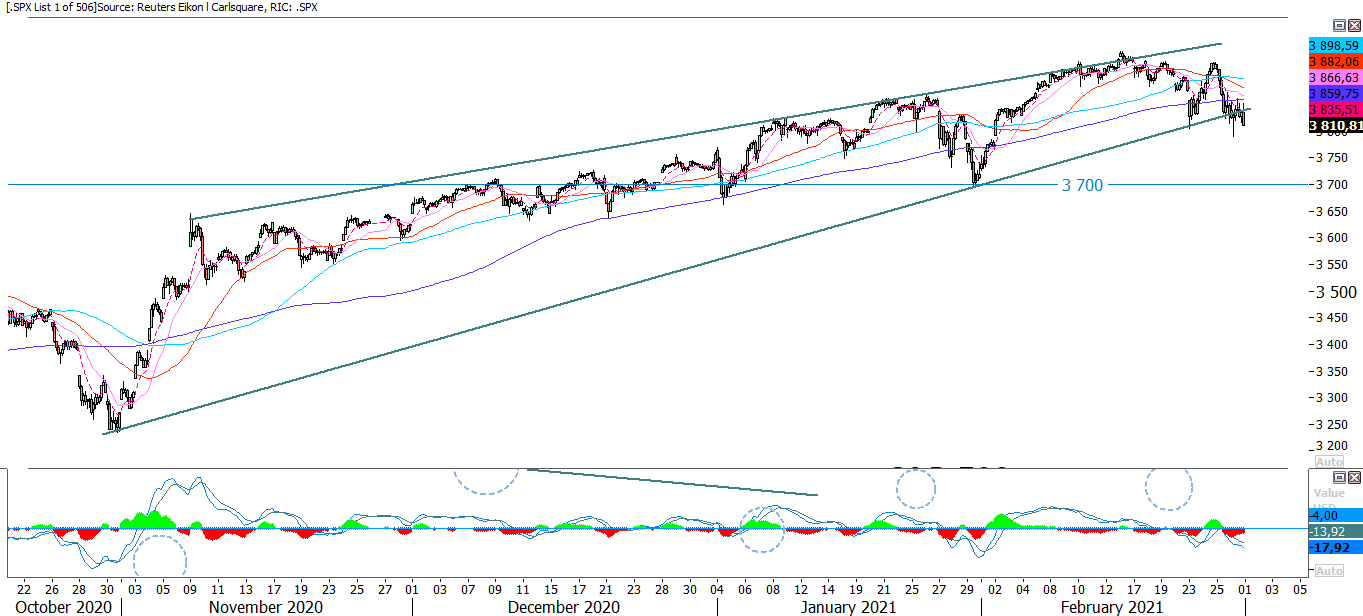Increased drama in the fixed income market. Crash or popcorn?


Where is the pain threshold for central banks now that interest rates are rising? What is happening now is that the market does not trust the artificial levels at which the bonds are traded. The risk-adjusted return regarding cost of capital and expected inflation rate, simply does not justify the purchase of bonds for an ordinary asset manager.
Where is the pain threshold for central banks now that interest rates are rising?

Looking at the daily graph, no clear answer is given. Like a Tesla stock, the 10-year US government bond yield can continue to rise, before finally breaking down. As for this 10-year interest rate, its course is cared for by the world´s most powerful organization – the US Federal Reserve. Our starting point is that if interest rates rise so fast that they challenge the rise of the stock markets, the Fed will trade rates down, simply by buying bonds massively.

According to the monthly graph above, interest rates are already up at the strong resistance level at 1.5 percent. Note that the MA50 is at 2 percent, which is therefore a very natural next level for interest rates. Who knows how many high leveraged and misplaced hedge funds will collapse at 2 percent interest rates? Not anyone. We know from previous financial crisis that the potential domino effects are incalculable. The market has historically had no major problems dealing with rising interest rates if it takes place in an orderly manner and in step with development on the stock market. But this kind of rapid rises in interest rates create great concern. This is since there are plenty of wounded whales that can die and float to the surface and affect other financial players. This can trigger a difficult-to-control chain reaction.
The central banks are aware of this. That is why they are so nervous about trying to handle every price fall in the financial system. Each time, it creates buying opportunities for investors who buy during the downturns.
What is happening now is that the market does not trust the artificial levels at which the bonds are traded. The risk-adjusted return regarding cost of capital and expected inflation rate, simply does not justify the purchase of bonds for an ordinary asset manager.
The Fed has already been buying USD 80 billion a month in bonds and government securities since June to support the market. In addition, the bank buys mortgage bonds for USD 40 billion per month.

The Fed's balance sheet swells as the bank de facto takes over the US government debt. See the blue line above. But despite these persistent purchases, interest rates are now rising.
The drama can be seen in the real interest rate now is rising above 0 percent for the first time since the Covid crisis hit.
In the latest interest rate protocol, the Fed´s wrote that they had given order to their trading desk at the Fed in New York “to increase holdings of Treasury securities and agency MBS by additional amounts and purchase agency commercial mortgage-backed securities (CMBS) as needed to sustain smooth functioning of markets for these securities.”
In Europe, Greece´s central bank governor Yannis Stournaras is the first to request major bond purchases from the ECB ahead of the ECB meeting on March 11.
It would not surprise us for a second if it is now the big investment banks that buy the bonds that the Fed is now dumping out. This is since these investment banks know that the Fed will have to buy them back in any case.
Here is the list of current primary dealers for Feds trading in New York, which is a list that include all the major investment banks:
https://www.newyorkfed.org/markets/primarydealers
It is only to realize that it is not a functioning market economy that we have to relate to. It is instead a matter of positioning oneself based on whether the Fed and other central banks can handle the increasingly escalating situation that investment banks and ordinary manager begin to sell bonds. Will the central banks be quick enough to parry this? Alternatively, should the markets go down a proper turn first? Regardless of the process, we expect that the central banks will eventually rectify the situation. As usual, keep you ear close to the rails and avoid being run over by the incoming train.
Hopes for a rapid end to Covid-19 and a shortage of copper in Asia have led to a rapid rise in copper prices. Did this rise reach its peak last Friday? The copper price stayed at EMA9, which is the first line of defence. Note the sell signal in RSI14 when it passes below 70. This graph is highly interesting in the coming days as it will be able to tell where the most fast-moving capital is going.

Swedish Boliden’s share also fell on Friday and as shown in the graph below, EMA9 serves as support. Will Boliden follow Copper – up or down?

The junk bond market clearly shows that all risk appetite has disappeared in just two days. Looking at this graph alone, it is urgent for the Fed to act in the fixed income market if it does not want to trigger a major price decline. Below is HYG, the ETF for junk bonds that is approaching MA100:

Looking at Nasdaq, it appears that all dips have constituted buying opportunities. But this time it is a little different…

Tesla stock bounced of MA100 but is once again under pressure:

The daily graph for the S&P500 index shows how the MA50 is tested. It is of course very important for the trend that this level hold. This is also the level that the major finance sites in the United States have a strong focus on. Will it hold or not?

In the 2-hour graph, the S&P500 index breaks down below the support line. It looks a bit like a bear trap, i.e., like a break under the support line to trick sellers. Today's trading will provide the answer.

German DAX index never managed to close above its previous top from January. Instead, the index closed below MA50 on Friday. Is 13 500 next?

The OMXS30 index had some intraday volatility during Friday but closed right below MA20:

One might think that the price of gold should rise when inflation expectations rise and Bitcoin falls. But no – is the 1 700-level and MA100 next? See weekly graph below:

The USD strengthened relatively hefty against the euro on Friday. Will the short rising trend hold? Note MACD that has generated a buy signal:

Risks
This information is in the sole responsibility of the guest author and does not necessarily represent the opinion of Bank Vontobel Europe AG or any other company of the Vontobel Group. The further development of the index or a company as well as its share price depends on a large number of company-, group- and sector-specific as well as economic factors. When forming his investment decision, each investor must take into account the risk of price losses. Please note that investing in these products will not generate ongoing income.
The products are not capital protected, in the worst case a total loss of the invested capital is possible. In the event of insolvency of the issuer and the guarantor, the investor bears the risk of a total loss of his investment. In any case, investors should note that past performance and / or analysts' opinions are no adequate indicator of future performance. The performance of the underlyings depends on a variety of economic, entrepreneurial and political factors that should be taken into account in the formation of a market expectation.